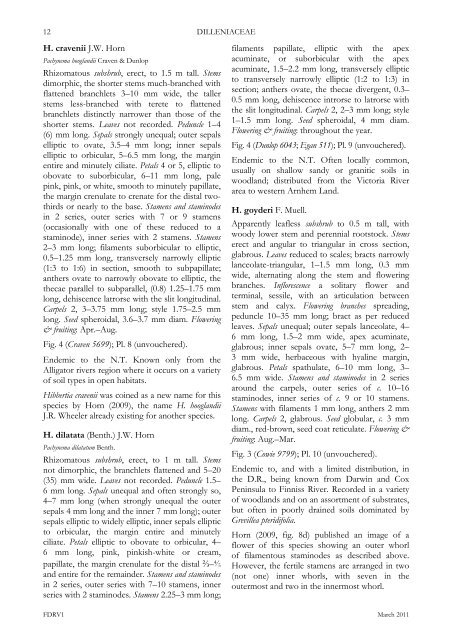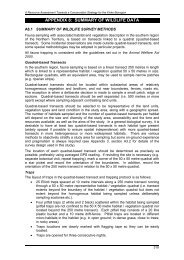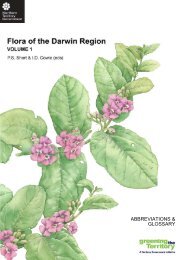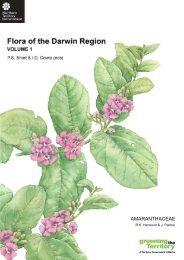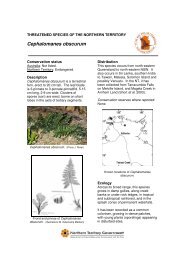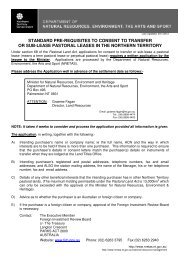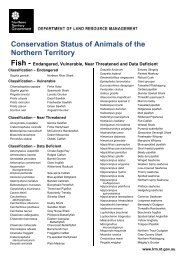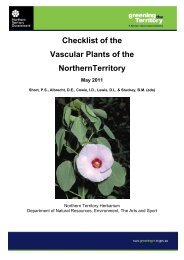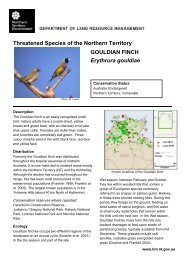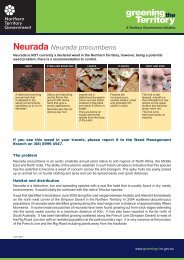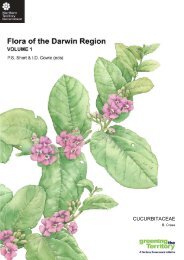DILLENIACEAE - Department of Land Resource Management ...
DILLENIACEAE - Department of Land Resource Management ...
DILLENIACEAE - Department of Land Resource Management ...
You also want an ePaper? Increase the reach of your titles
YUMPU automatically turns print PDFs into web optimized ePapers that Google loves.
12<br />
H. cravenii J.W. Horn<br />
Pachynema hooglandii Craven & Dunlop<br />
Rhizomatous subshrub, erect, to 1.5 m tall. Stems<br />
dimorphic, the shorter stems much-branched with<br />
flattened branchlets 3–10 mm wide, the taller<br />
stems less-branched with terete to flattened<br />
branchlets distinctly narrower than those <strong>of</strong> the<br />
shorter stems. Leaves not recorded. Peduncle 1–4<br />
(6) mm long. Sepals strongly unequal; outer sepals<br />
elliptic to ovate, 3.5–4 mm long; inner sepals<br />
elliptic to orbicular, 5–6.5 mm long, the margin<br />
entire and minutely ciliate. Petals 4 or 5, elliptic to<br />
obovate to suborbicular, 6–11 mm long, pale<br />
pink, pink, or white, smooth to minutely papillate,<br />
the margin crenulate to crenate for the distal twothirds<br />
or nearly to the base. Stamens and staminodes<br />
in 2 series, outer series with 7 or 9 stamens<br />
(occasionally with one <strong>of</strong> these reduced to a<br />
staminode), inner series with 2 stamens. Stamens<br />
2–3 mm long; filaments suborbicular to elliptic,<br />
0.5–1.25 mm long, transversely narrowly elliptic<br />
(1:3 to 1:6) in section, smooth to subpapillate;<br />
anthers ovate to narrowly obovate to elliptic, the<br />
thecae parallel to subparallel, (0.8) 1.25–1.75 mm<br />
long, dehiscence latrorse with the slit longitudinal.<br />
Carpels 2, 3–3.75 mm long; style 1.75–2.5 mm<br />
long. Seed spheroidal, 3.6–3.7 mm diam. Flowering<br />
& fruiting: Apr.–Aug.<br />
Fig. 4 (Craven 5699); Pl. 8 (unvouchered).<br />
Endemic to the N.T. Known only from the<br />
Alligator rivers region where it occurs on a variety<br />
<strong>of</strong> soil types in open habitats.<br />
Hibbertia cravenii was coined as a new name for this<br />
species by Horn (2009), the name H. hooglandii<br />
J.R. Wheeler already existing for another species.<br />
H. dilatata (Benth.) J.W. Horn<br />
Pachynema dilatatum Benth.<br />
Rhizomatous subshrub, erect, to 1 m tall. Stems<br />
not dimorphic, the branchlets flattened and 5–20<br />
(35) mm wide. Leaves not recorded. Peduncle 1.5–<br />
6 mm long. Sepals unequal and <strong>of</strong>ten strongly so,<br />
4–7 mm long (when strongly unequal the outer<br />
sepals 4 mm long and the inner 7 mm long); outer<br />
sepals elliptic to widely elliptic, inner sepals elliptic<br />
to orbicular, the margin entire and minutely<br />
ciliate. Petals elliptic to obovate to orbicular, 4–<br />
6 mm long, pink, pinkish-white or cream,<br />
papillate, the margin crenulate for the distal ⅔– 4⁄5<br />
and entire for the remainder. Stamens and staminodes<br />
in 2 series, outer series with 7–10 stamens, inner<br />
series with 2 staminodes. Stamens 2.25–3 mm long;<br />
<strong>DILLENIACEAE</strong><br />
filaments papillate, elliptic with the apex<br />
acuminate, or suborbicular with the apex<br />
acuminate, 1.5–2.2 mm long, transversely elliptic<br />
to transversely narrowly elliptic (1:2 to 1:3) in<br />
section; anthers ovate, the thecae divergent, 0.3–<br />
0.5 mm long, dehiscence introrse to latrorse with<br />
the slit longitudinal. Carpels 2, 2–3 mm long; style<br />
1–1.5 mm long. Seed spheroidal, 4 mm diam.<br />
Flowering & fruiting: throughout the year.<br />
Fig. 4 (Dunlop 6043; Egan 511); Pl. 9 (unvouchered).<br />
Endemic to the N.T. Often locally common,<br />
usually on shallow sandy or granitic soils in<br />
woodland; distributed from the Victoria River<br />
area to western Arnhem <strong>Land</strong>.<br />
H. goyderi F. Muell.<br />
Apparently leafless subshrub to 0.5 m tall, with<br />
woody lower stem and perennial rootstock. Stems<br />
erect and angular to triangular in cross section,<br />
glabrous. Leaves reduced to scales; bracts narrowly<br />
lanceolate-triangular, 1–1.5 mm long, 0.3 mm<br />
wide, alternating along the stem and flowering<br />
branches. Inflorescence a solitary flower and<br />
terminal, sessile, with an articulation between<br />
stem and calyx. Flowering branches spreading,<br />
peduncle 10–35 mm long; bract as per reduced<br />
leaves. Sepals unequal; outer sepals lanceolate, 4–<br />
6 mm long, 1.5–2 mm wide, apex acuminate,<br />
glabrous; inner sepals ovate, 5–7 mm long, 2–<br />
3 mm wide, herbaceous with hyaline margin,<br />
glabrous. Petals spathulate, 6–10 mm long, 3–<br />
6.5 mm wide. Stamens and staminodes in 2 series<br />
around the carpels, outer series <strong>of</strong> c. 10–16<br />
staminodes, inner series <strong>of</strong> c. 9 or 10 stamens.<br />
Stamens with filaments 1 mm long, anthers 2 mm<br />
long. Carpels 2, glabrous. Seed globular, c. 3 mm<br />
diam., red-brown, seed coat reticulate. Flowering &<br />
fruiting: Aug.–Mar.<br />
Fig. 3 (Cowie 9799); Pl. 10 (unvouchered).<br />
Endemic to, and with a limited distribution, in<br />
the D.R., being known from Darwin and Cox<br />
Peninsula to Finniss River. Recorded in a variety<br />
<strong>of</strong> woodlands and on an assortment <strong>of</strong> substrates,<br />
but <strong>of</strong>ten in poorly drained soils dominated by<br />
Grevillea pteridifolia.<br />
Horn (2009, fig. 8d) published an image <strong>of</strong> a<br />
flower <strong>of</strong> this species showing an outer whorl<br />
<strong>of</strong> filamentous staminodes as described above.<br />
However, the fertile stamens are arranged in two<br />
(not one) inner whorls, with seven in the<br />
outermost and two in the innermost whorl.<br />
FDRV1 March 2011


